Derrick Rose's Adidas Contract: Breaking Down the Strange Terms

In early 2012, Derrick Rose was one of the most dynamic young players the NBA had ever seen. A season earlier he became the youngest player in NBA history to win the league’s MVP award. The No. 1 overall pick from the 2008 NBA draft electrified his hometown Chicago Bulls in ways that were reminiscent of Michael Jordan.
Like any apparel company, Adidas saw Rose as an athlete whose endorsement could dramatically boost sales. Adidas and Rose’s representatives negotiated a 14-year endorsement deal worth, at a minimum, nearly $190 million. Rose would net additional tens of millions if his endorsed products sold well, or if he made promotional appearances on behalf of Adidas and won player awards.
The contract would pay Rose extremely well but would also demand much of him. He would be required to carry the Adidas flag in how he conducted his career, how he interacted with the public and even in how he dressed.
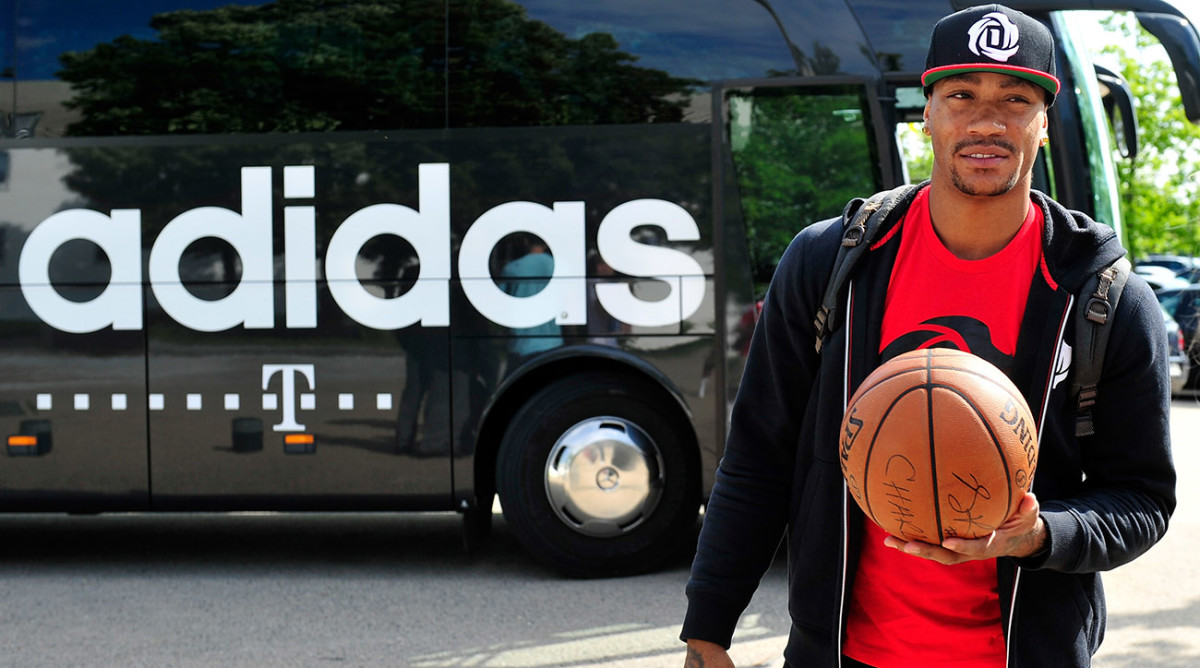
Back then no one could have predicted that Rose’s career would go off the rails, especially so fast. Just 64 days after Rose signed his mammoth deal with Adidas, Rose would tear his ACL in a playoff game against the Philadelphia 76ers. He would miss the entire following season. It would be the first of several significant injuries that would often keep Rose off the court.
Rose also encountered difficulties in his conduct. He was accused of raping a woman, who brought him to court in a high-profile (albeit unsuccessful) civil trial in 2016. Rose has also battled with his coaches and, at times, become estranged from his team.
Why is Adidas Still Paying Derrick Rose Superstar Money?
Knowing what it knows now, Adidas almost certainly would not have signed Rose to such an enormous and lengthy contract on Feb. 24, 2012.
Yet for reasons that remain unknown, Adidas—a publicly traded company—has repeatedly declined to invoke contractual language that would have permitted the company to substantially reduce its financial obligations to Rose or even terminate the contract altogether. Jon Wertheim’s story reveals and details this unusual dynamic. Below I annotate 20 key excerpts from the endorsement deal. These annotations shed light on both the scope of the contract and Adidas’s strange indecision in responding to Rose’s troubles.
(Editor's note: The following excerpts were taken via screen grab from Derrick Rose's official contract with Adidas.)
1. Explaining why Rose’s company—rather than Rose himself—signed the endorsement deal with Adidas
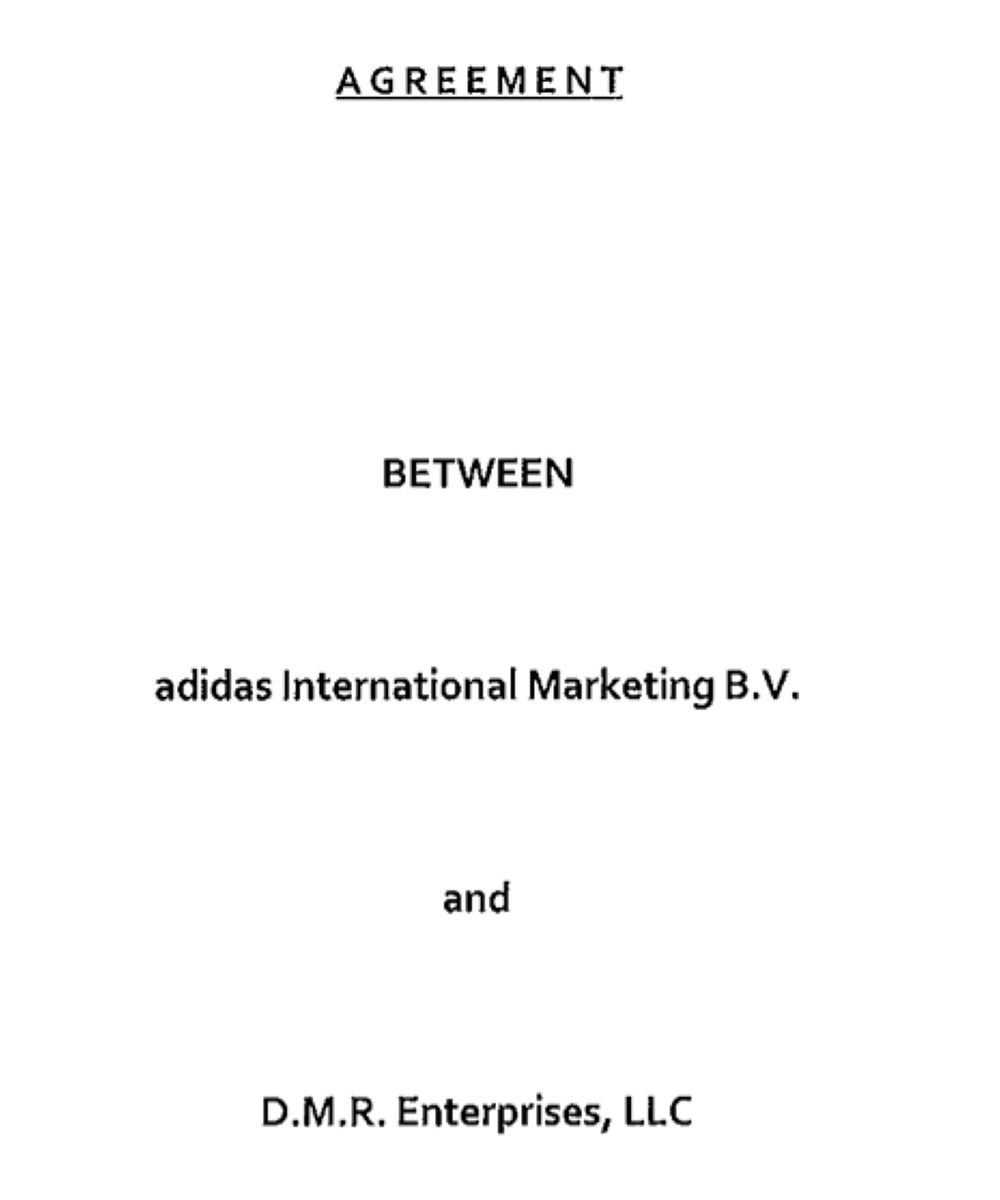
McCann: When an athlete and a company agree to an endorsement contract, often the athlete does not, technically, enter into the contract themselves. Instead, a separate company on the athlete’s behalf agrees to the deal.
The Derrick Rose contract with Adidas International Marketing illustrates such an arrangement. Adidas didn’t sign Rose to an endorsement deal. Instead, it reached a contract with “D.M.R. Enterprises, LLC.” D.M.R. stands for Derrick Martell Rose and LLC refers to a limited liability company. The contract indicates that D.M.R. Enterprises has space in a Chicago office building but its mailing address refers to an office for the Wasserman Media Group located in a Los Angeles office building.
Why wouldn’t Rose sign the contract himself? Because by signing through an LLC, Rose absorbed less financial risk and better protected his money from liability.
Although there are a variety of circumstances that can “pierce” the so-called “corporate veil,” an LLC is structured as a separate entity from its owner. As a result, both are treated as separate entities for purposes of liability—a significant point for Rose given that he was (unsuccessfully) sued by a woman who claimed that he had raped her. Depending on how it is configured, an LLC can also offer its owners tax advantages.
2. Definition of “player awards” and how it impact Rose’s earnings

McCann: At different points in Rose’s contract, the distinction of him earning an “All Pro Award” surfaces. Earning this award obligates Adidas to pay him much more money. It’s clear, then, that Rose being honored with such an award is a meaningful achievement in the eyes of both Rose and Adidas.
There’s a problem, however. There is no such thing as an “All Pro Award” in the NBA. This isn’t the NFL, after all.
The reason why Rose and Adidas refer to a non-existent NBA award is because “All Pro” is a contractual term of art that serves as a catchall for actual NBA awards.
Specifically, “All Pro Award” is defined as the MVP award, selection to the NBA All-Star Game, winning an NBA championship, election or selection to the First Team All-NBA, Second Team All-NBA or Third Team All-NBA. Rather than having to frequently regurgitate that list within the contract, the contract more efficiently uses the expression “All Pro”.
3. Definition of “competitor” and how it impacts Rose’s responsibilities under the contract (page 3)

McCann: Adidas has not only agreed to pay Rose millions of dollars to endorse its products. It also pays him to not endorse any products made by any of Adidas’ competitors.
To that end, Adidas was careful to define “competitor” as broadly as possible. The definition doesn’t mention Nike, New Balance, Under Armour or any other company by name. Instead, it places the onus on Rose to find out if associating with another product or company could cause Rose to breach the contract.
When possible, players’ agents normally check with sponsored companies before their client attempts to associate with a potential rival company. But sometimes the player acts without the agent’s knowledge. A good agent, however, stresses to his or her client of the need to have continuous dialogue with the endorsed company in order to avoid unintentionally violating the contract.
4. Definition of “formal wear” that Rose is expected to wear

McCann: We live in a world where being instructed to wear “business casual” to an event often sparks confusion. Does “business causal” mean you need to wear a tie or at least a jacket? It often depends on who you ask, which sort of defeats the point of using a uniform moniker that is supposed to clarify rather than confound.
As an apparel company, Adidas is especially aware that categories of clothing can mean different things to different people.
To avoid the risk of Rose and Adidas having conflicting understandings of fashion terms, the contract painstakingly defines categories of clothing. One such category is “formal wear”, which is defined as meaning “a combination of Adidas products with morning dress, lounge and/or dinner suits, handkerchiefs, braces, cummerbunds, formal shoes, formal shirts and cufflinks from the top ranges of mutually agreed upon brands.”
5. Definition of “products” for which Rose must be mindful
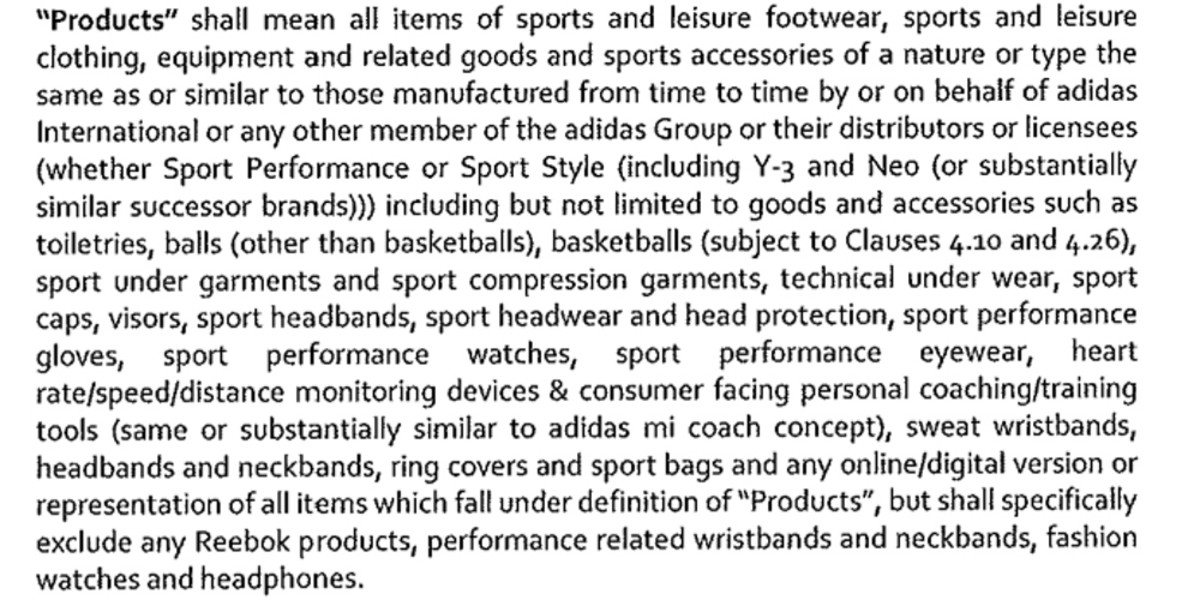
McCann: Throughout the endorsement deal, Adidas frequently reminds Rose of the exclusivity of their agreement. This is clear in how the contract defines “products.” The contract instructs Rose that he cannot wear or otherwise endorse products made by Adidas’ rivals. To ensure that Rose understands the scope of “products” that Adidas manufacturers, “products” is defined broadly to include all items of sports and leisure footwear, clothing, equipment and “related goods.” “Products” is also defined to include items made by other companies associated with Adidas. As a result, the scope of relevant “products” includes toiletries and heart–rate monitoring devices.
The contract also uses the phrase “same as or similar to” various Adidas products. The words “similar to” are critical since they are deliberately vague and may require interpretation. The company wants representatives of Rose to reach out to Adidas before Rose wears or publicly uses a product that Adidas might consider to be a rival product. Adidas employing far-reaching and ambiguous language advances that objective.
6. Definition of “promotional appearances” as it relates to Rose
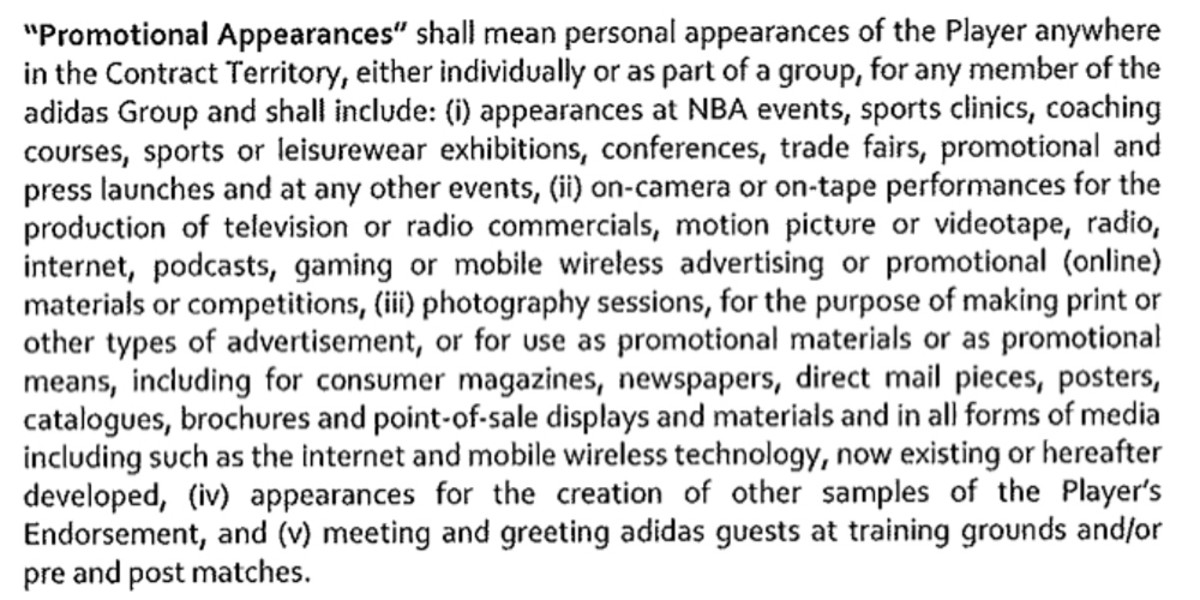
McCann: When Rose thinks of his “team”, he probably envisions the NBA franchise that employs him as well as his NBA teammates and coaches. Adidas wants Rose to know that he is also obligated to think of it as his team.
To that end, Adidas uses the contract to make sure Rose understands that he is “on the clock” for Adidas in a wide-range of promotional activities. They include NBA events, TV ads and—to protect Adidas in the event that emerging technologies lead to new forms of advertising—photography sessions “in all forms of media including such as the Internet and mobile wireless technology, now existing or hereafter developed.”
7. Making sense of the lengthiness of the Rose endorsement deal
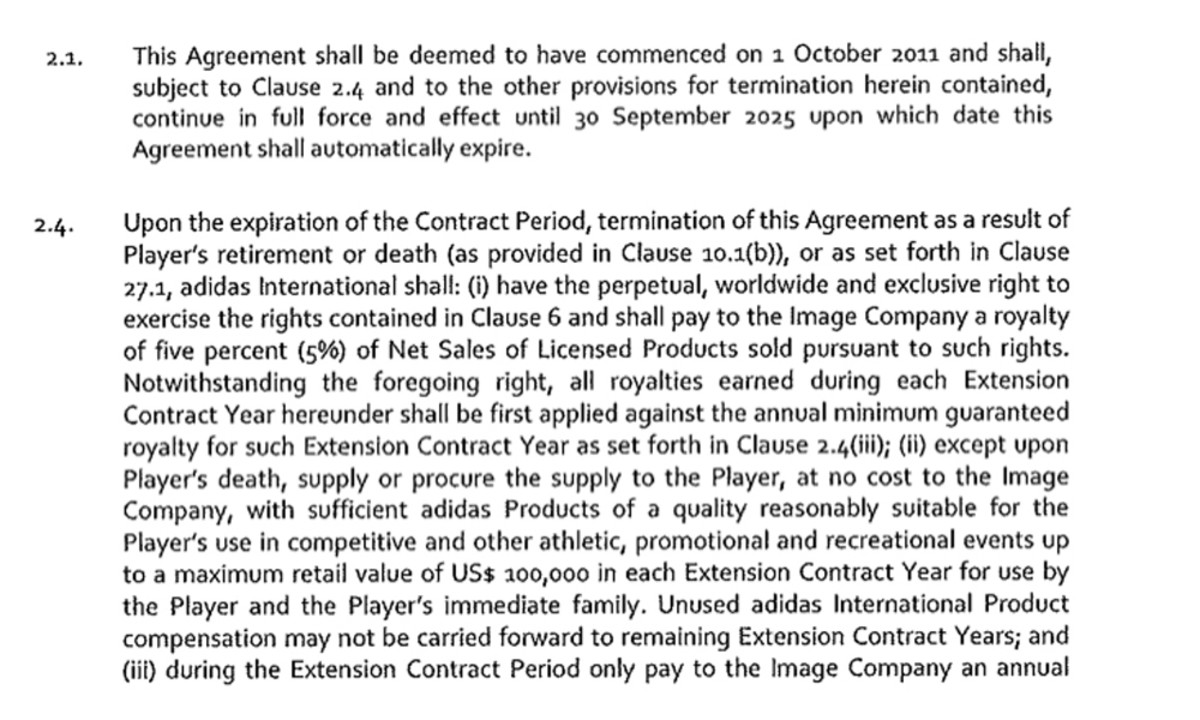
McCann: At first glance, the length of Rose’s contract with Adidas might seem oddly long. The deal goes from Oct. 1, 2011 to Sept. 30, 2025. Rose, who was the No. 1 pick in the 2008 NBA draft, was 22 years old when the contract began. He was coming off his best season in the NBA. He averaged 25 points and eight assists per game for the Bulls in the 2010-11 season and became the youngest MVP in NBA history. He continued his excellent play into the 2011-12 season. Back then, it seemed like Rose would go on to an amazing NBA career—maybe even a Hall of Fame career.
But Rose’s situation would change dramatically. He suffered serious injuries to both of his knees. Although his surgeries were successful, they may have robbed him of some of his elite quickness. The now 29-year-old has also encountered assorted controversies, most disturbingly an accusation of rape. It’s also not clear that Rose’s heart is fully in the game, as he recently contemplated retiring from the sport. Rose is hardly the kind of athlete Adidas would prefer to be the face of the company in 2018.
Yet put yourself back in 2011. Rose was a young and dynamic superstar on the rise. He seemed poised to have a long and marketable career. It was plausible that Rose could play at a high level in the NBA until age 36, the age at which his endorsement deal is scheduled to end.
Adidas, however, hedged its bet on Rose’s career. As the contract makes clear, the deal could be terminated if Rose retires from basketball prior to 2025. This clause may be one reason why Rose has decided to continue his career: if he retires anytime soon, he would forgo being paid tens of millions of dollars.
Unfortunately for Adidas, the “worst-case scenario" in signing Rose to such a massive contract may be playing out. His career has regressed to a point where he is much less marketable than at the time Adidas signed him, but he has not regressed to the point where he can’t find employment playing basketball. In fact, so long as Rose remains reasonably healthy, he’ll likely find work in the NBA or other pro hoop leagues for a number of years to come. And so long as that happens, Adidas will have to pay him.
8. Why Adidas agreed to pay Rose so much money and at different rates depending on the season
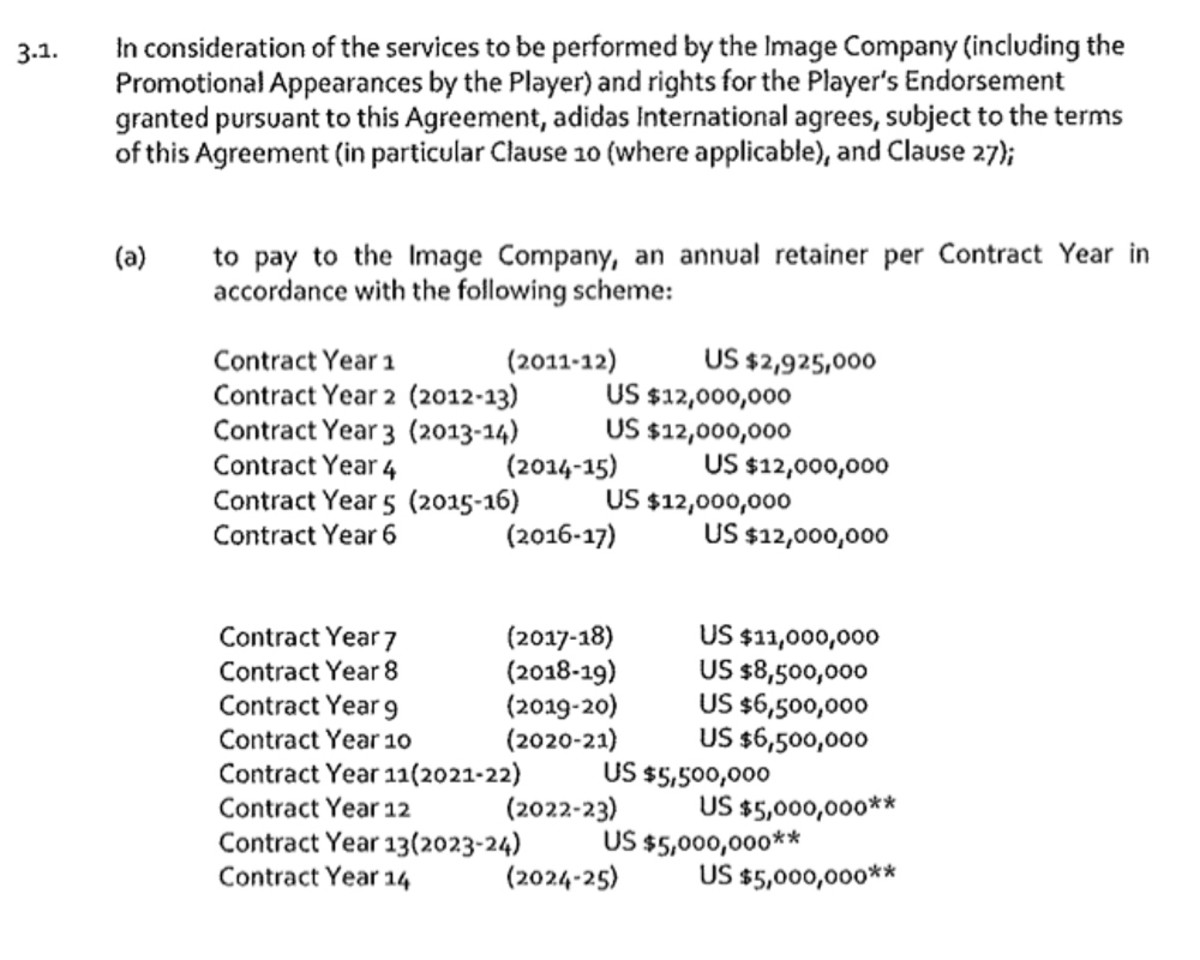
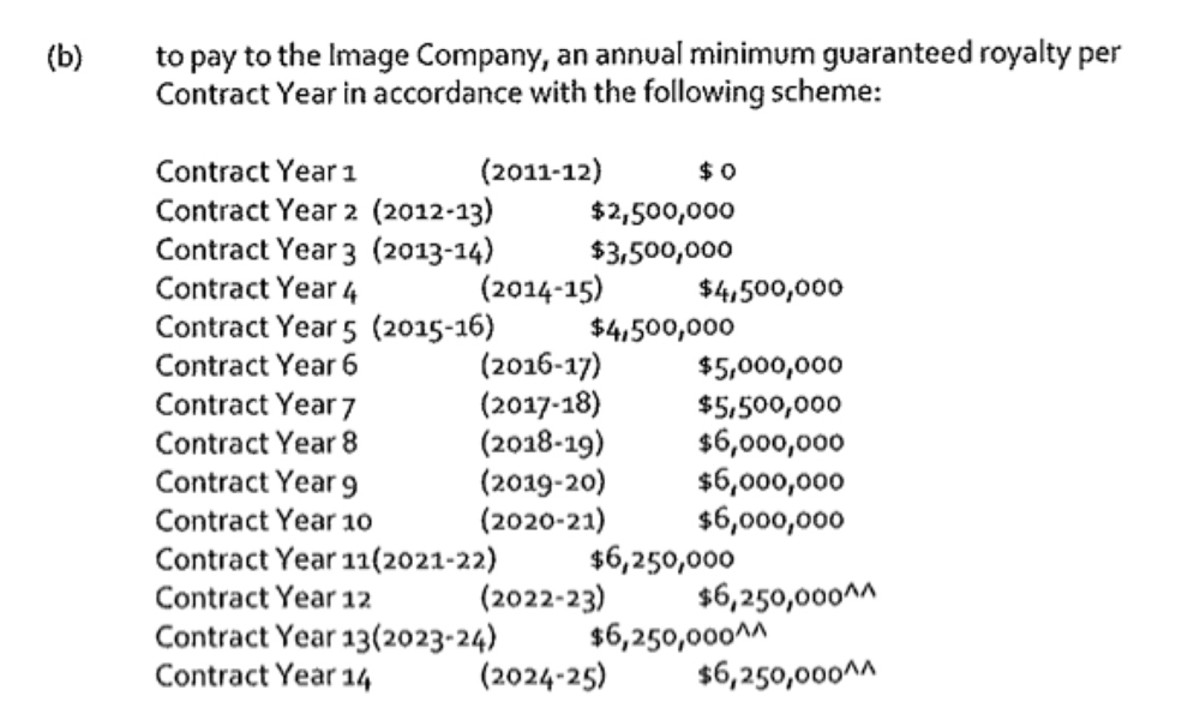
McCann: To put it mildly, Rose broke the bank with his Adidas contract. While Rose’s NBA salary was still constricted by the rookie wage scale at the time he contracted with Adidas, the deal with Adidas would soon infuse him with massive wealth. By the 2012-13 season, Adidas was obligated to pay Rose a retainer of $12 million along with a minimum royalty payment of $2.5 million.
Adidas’s payments to Rose were structured with his likely NBA career arc in mind. Rose was entitled to the highest minimum amount during the 2016-17 NBA season. That year, Adidas was obligated to pay him—at a minimum—$17 million in retainer and royalty payments.
Back in 2011, Adidas likely figured that Rose would be in the prime of his career during the 2016-17 season. He would be 28 years old that season and 28 is often the age when an NBA player is at his peak. The company probably also reasoned that by the middle part of the decade, Rose’s marketability would be similar to that of established superstars like LeBron James or Kobe Bryant. That may seem hard to believe now, but remember, Rose had just become the youngest recipient of the MVP award in league history. He was the real deal, it seemed. Adidas did not know—and could not have known—that Rose’s best days were behind him and that his peak year would occur when he was only 22.
Furthermore, while Adidas no doubt carefully researched Rose’s character and background, it had no specific reason to know that he would be accused of sexual assault years later and or that he would become regarded as something of a malcontent. In 2011, Rose’s previous troubles could have been attributed to youthful indiscretion. For instance, Rose was fined $1,000 for driving over 100 miles per hour on an Illinois highway in 2008. A year later the NCAA vacated Memphis Tigers wins because another person allegedly took Rose’s SAT so that he would score high enough to gain academic eligibility under NCAA rules. Although those were to some extent “warning signs”, Adidas likely concluded that as Rose aged into his mid–20s, he would gradually mature into the life of an NBA superstar.
9. Adidas protects itself from Rose failing to play—but the company declines to invoke those protections
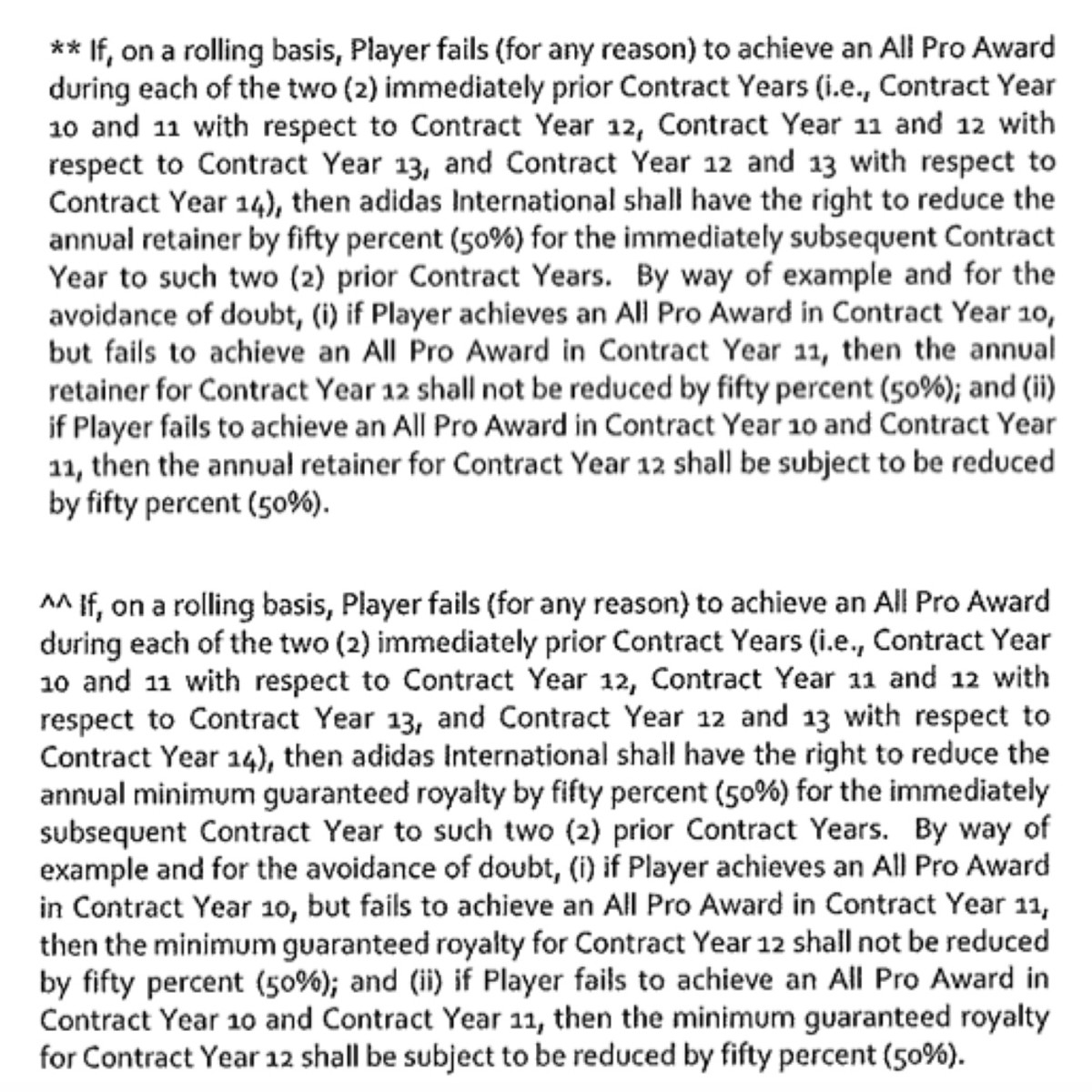
McCann: Adidas wisely included provisions that empowered the company to substantially reduce its financial obligations to Rose in the event his NBA career veered off course. Specifically, if he failed to achieve an "All Pro" award two years in a row, Adidas could reduce its payments to him by 50%.
As we know now, Rose’s career did, in fact, veer off course. His last "All Pro" award occurred in the 2011-12 season, when he made the Eastern Conference All-Star team. While Rose enjoyed several productive seasons in the years that followed, none triggered a relevant award for purposes of the Adidas contract.
Yet, as Jon Wertheim reveals in his story, Adidas repeatedly declined to invoke its reduction provision. While Adidas was under no obligation to pay Rose less money, it’s unclear why the publicly-traded company would not do so when presented with the opportunity. Adidas’ decision-making is especially hard to understand given Rose’s off-court controversies, which included a highly publicized civil trial for alleged sexual assault.
The company may be concerned that reducing Rose’s payments could cause its other endorsed athletes to question the company’s loyalty to its players. Yet, as Wertheim writes, Adidas terminated its deal with Boston Celtics guard Terry Rozier last December merely because he wore a pair of Nike sneakers in a pregame shootaround.
10. Rose uses Adidas contract to help AAU and high school basketball, which in turn helps Adidas
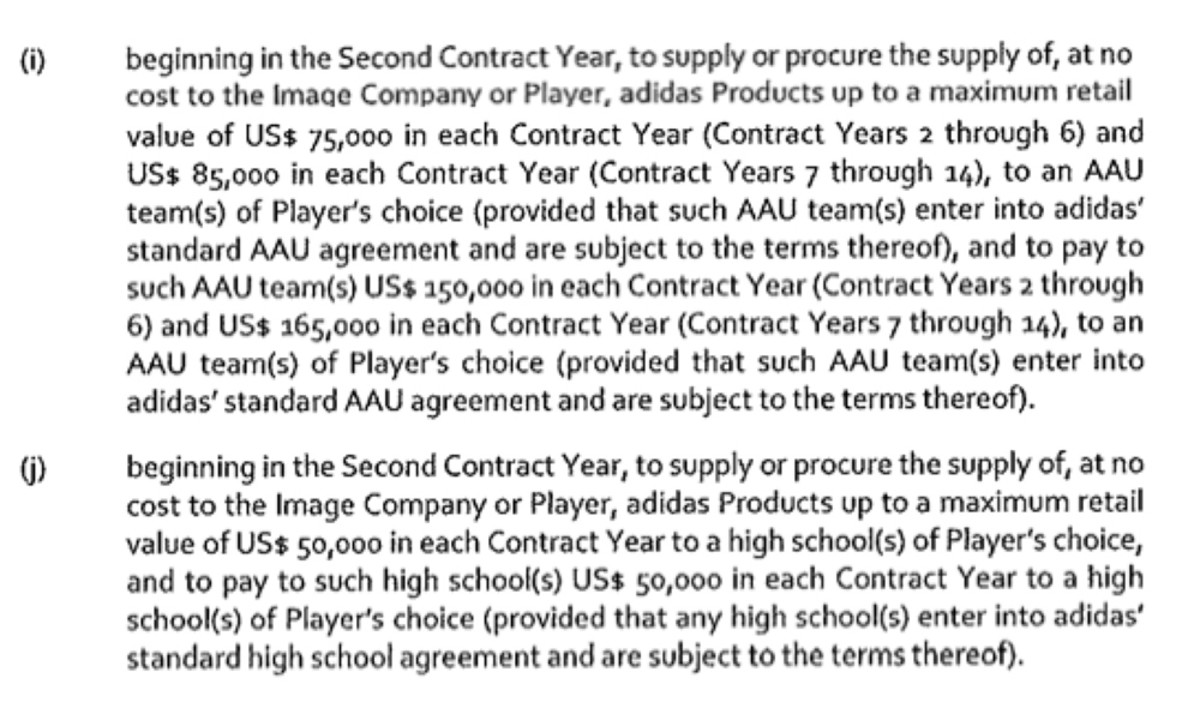
McCann: Rose has repeatedly said that he owes much of his development as a player to his time in AAU and high school basketball. In the mid-2000s, Rose played alongside future NBA player Eric Gordon for Chicago’s Mean Street Express AAU team. He also played for Simeon Career Academy, a high school in Chicago. It was during this time when Rose deeply impressed scouts and college coaches. One of these coaches was then-Memphis coach John Calipari. He remarked that Rose, “was a guy who chases greatness.” Rose would join Calipari for one year of college ball before entering the NBA.
Rose and his representatives negotiated for Adidas to pledge up to $165,000 a year worth of Adidas sneakers and other products in support of AAU team(s) of Rose’s choice. The company also agreed to provide up to $50,000 worth of sneakers and other products to high school(s) of Rose’s choice.
Of course, Adidas could have also benefited from such arrangements. As suggested by the college basketball criminal case involving Adidas officials, sneaker companies view AAU basketball as a way of steering star players towards college programs that are also associated with the sneaker company and with particular NBA agents.
11. Rose uses Adidas contract to help his family and friends
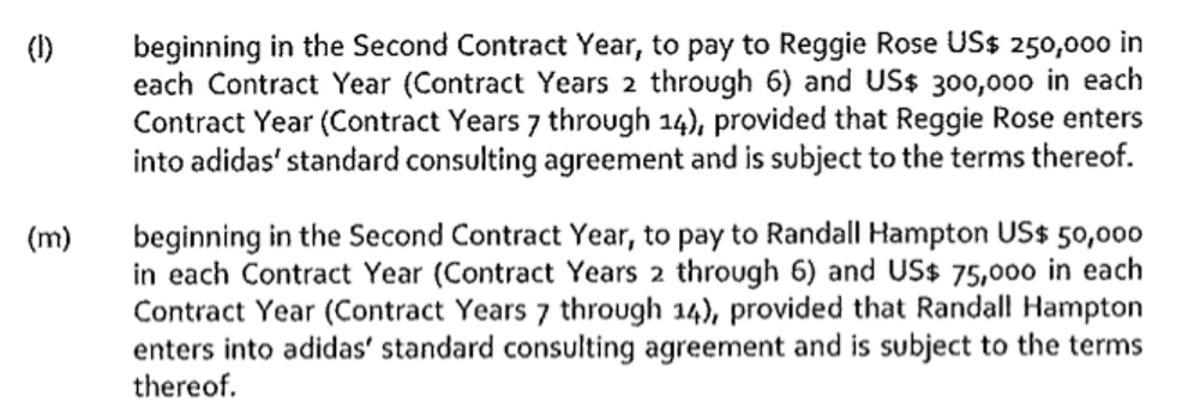
McCann: Perhaps to his detriment at times, Rose has proven to be very loyal to those around him.
Take Reggie Rose, who is Derrick’s older brother, mentor and business manager. Reggie Rose played college ball for the University of Idaho in the mid–90s and later helped his younger brother develop his skills and brand. Derrick Rose made sure Reggie would be well compensated by Adidas. The company agreed to pay the older Rose $250,000 to $300,000 a year from 2011 to 2025.
Derrick Rose also negotiated for Adidas to pay his childhood friend and employee Randall Hampton $50,000 to $75,000 a year from 2011 to 2015. If Hampton’s name sounds familiar, it may be because he was a co-defendant of Rose in the sexual assault trial. Rose and Hampton, along with fellow childhood friend/employee Ryan Allen, were accused of breaking into Los Angeles apartment in August of 2013 and raping a woman while she was intoxicated. In Oct. 2016, a federal jury found the three men not liable.
12. Rose is contractually obligated to wear Adidas products in many different settings
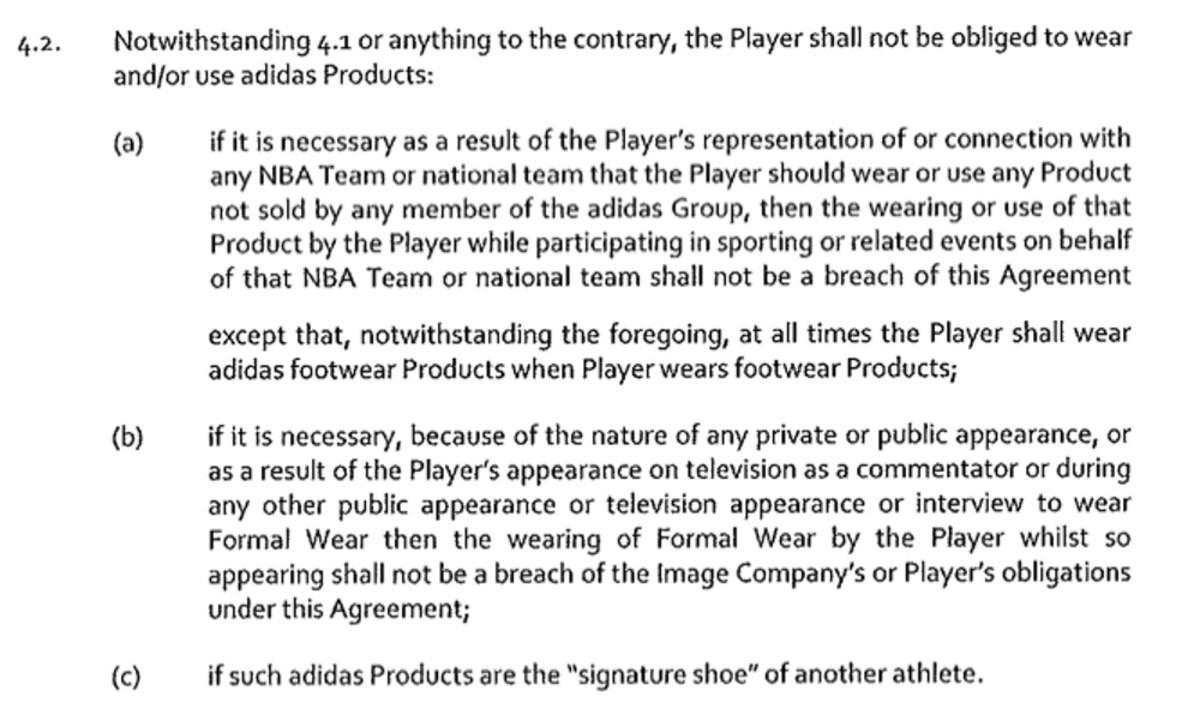
McCann: Adidas didn’t agree to pay Rose with the hope that he would wear its products when he appeared in public. It paid him to be obligated to wear those products.
The contract details the wide range of circumstances in which Rose has to wear Adidas. They include obvious settings, such as when he plays and practices as an NBA player, and also less obvious ones, such as when he merely appears as a spectator at a basketball game.
Rose is also generally obligated to wear Adidas in circumstances “where there is a reasonable expectation that media will be present.” The contract lists pop concerts and celebrity parties as illustrations of where there is a reasonable expectation that media will be present. Rose is obligated to know before he attends an event if there’s a reasonable expectation that media will be there.
13. Other than footwear, Rose isn’t contractually obligated to wear Adidas products when doing so would conflict with his NBA employment or participation on a national team

McCann: Adidas knows that endorsement deals wouldn’t make sense for it or the player if the deal compelled the player to violate other contracts or legal requirements. To that end, Adidas exempts Rose from having to wear Adidas clothing if doing so would cause him to violate his NBA contract. This term would become relevant in 2015 when Nike reached a deal with the NBA to replace Adidas as the provider of NBA uniforms. One exception: Rose must always wear Adidas footwear.
Adidas also permits Rose to wear non-Adidas apparel (so long as it is not footwear) in connection with any “national team.” In 2011, the inclusion of a “national team” was likely meaningful to Rose and his representatives. Rose was very likely going to represent Team USA in the London 2012 Summer Olympic Games. In January 2012 he was among 19 players selected for the preliminary roster.
But Rose’s devastating knee injury in April 2012 meant that he could not suit up for his country. Had Rose stayed healthy, he would have played for Team USA—the same Team USA that had struck a deal with Nike for the apparel company to sponsor and clothe U.S. Olympians.
14. Adidas buys valuable access to Rose’s social media pages
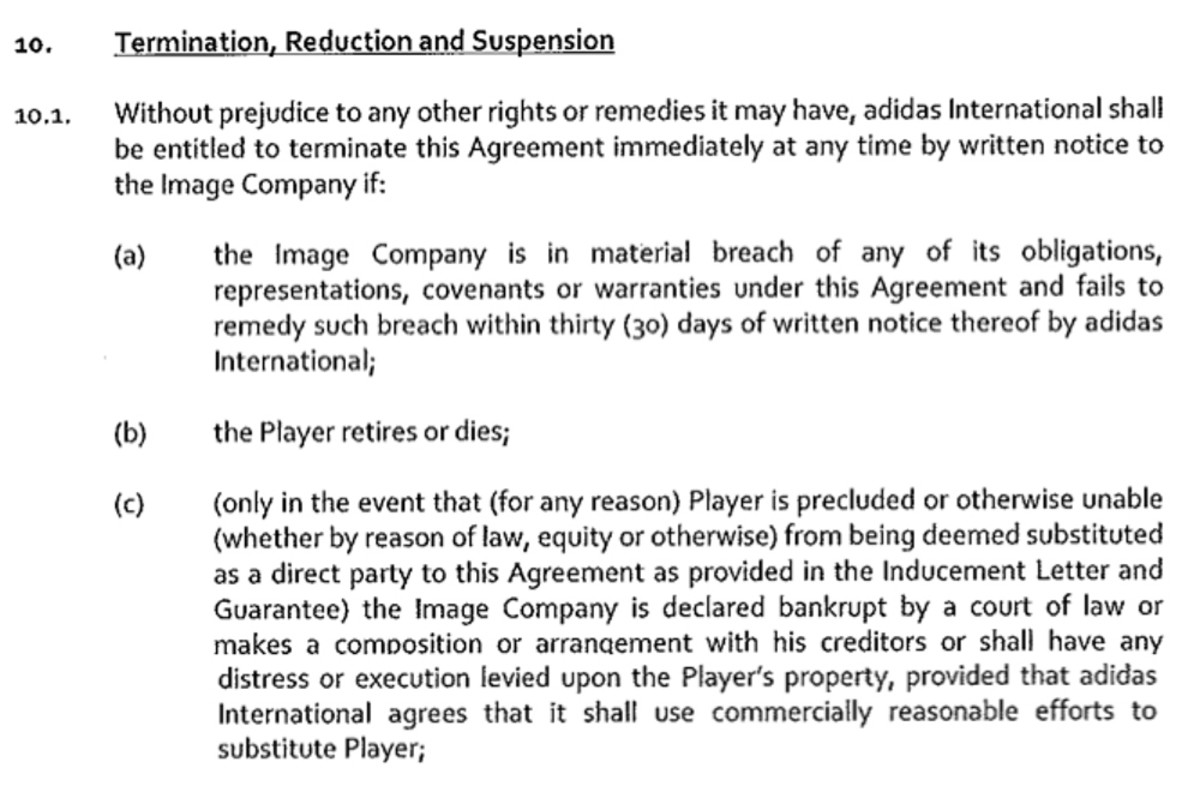
McCann: Derrick Rose doesn’t tweet very often—he’s tweeted only 54 times since he joined Twitter in 2012—but when he tweets, many people notice. Rose has 2.54 million followers on Twitter page, @drose.
The three most recent tweets on Rose’s page concern his connection to Adidas products and Adidas events. Many of his other tweets are also about Adidas.
Why is that?
One likely reason is that Adidas paid for the right to promote its products and assets on Rose’s social media pages. As the contract shows, Adidas can request that certain social media postings be made. The contract also notes that Rose or a representative of DMR Enterprises must, in a timely manner, give prior approval before any postings are made.
When companies evaluate the endorsement value of athletes, the size of those athletes’ social media followings is given considerable weight. Although Rose may not longer be as marketable as he once was, his substantial Twitter following is surely of value to Adidas.
15. Adidas is contractually entitled to terminate, reduce or suspend Rose’s endorsement contract but hasn’t invoked that right
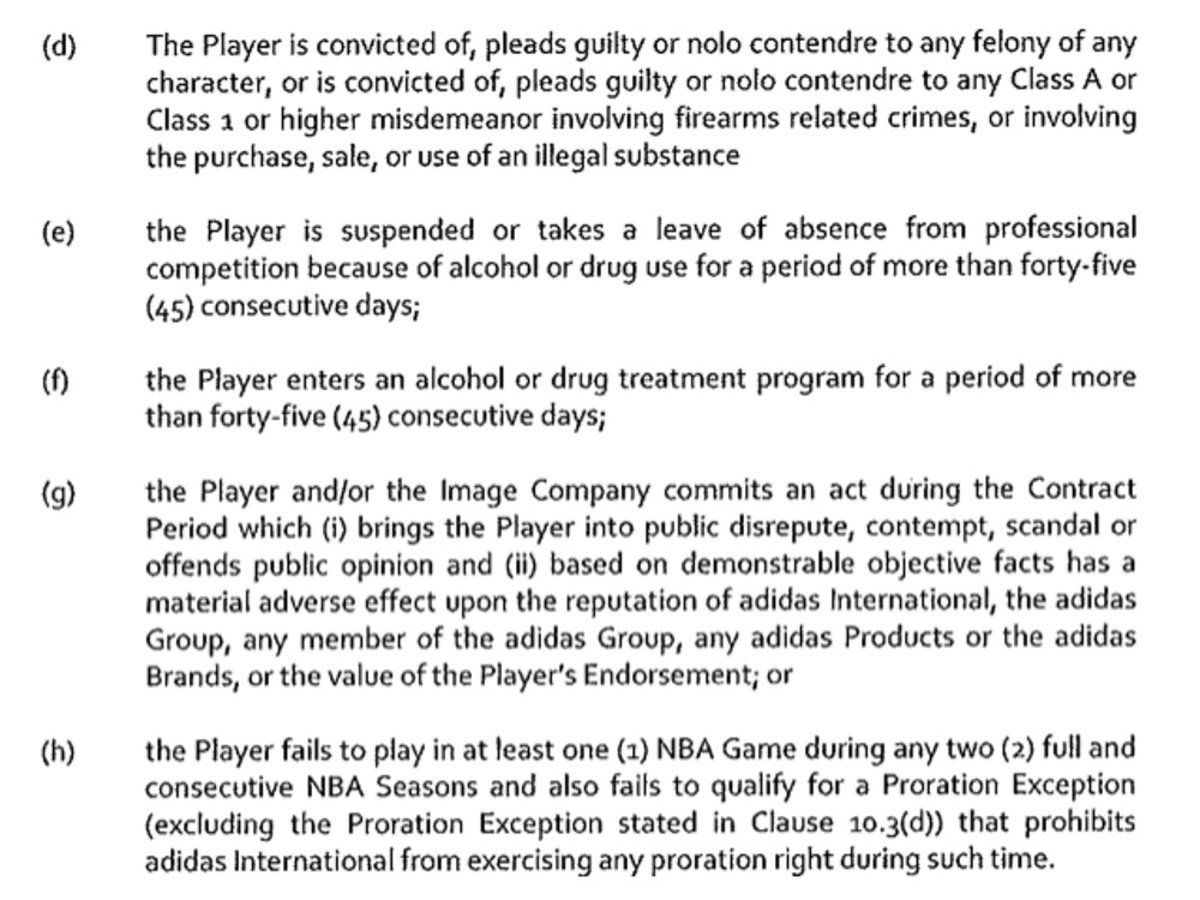
McCann: Like in any player endorsement deal with a major company, Adidas negotiated for language that would allow the company to exit its deal with Rose in the event he encounters controversy.
One such provision allows Adidas to terminate the contract if Rose commits an act “which (i) brings the player into public disrepute, contempt, scandal or offends public opinion and (ii) based on demonstrable objective facts has a material adverse effect upon the reputation of Adidas International, the Adidas Group, any member of the Adidas Group, any Adidas products or the Adidas Brands, or the value of the player’s endorsement.”
Rose was not charged with a crime, let alone convicted of one, stemming from the alleged sexual assault. Nonetheless, his testimony during the lawsuit raised serious questions about his judgment and particularly his treatment of women. For instance, Rose admitted under oath that he did not understand the word “consent” in the context of sexual relations with women. Also while under oath, Rose testified that his intentions on the evening in question could be summed up with two words: “We men”.
Even though Rose was found not liable, he and his “brand” came out of the trial much worse off. It probably would not be difficult for Adidas to accumulate data that shows having Rose represent the company harms the reputation of Adidas.
Yet as Wertheim details, Adidas has not attempted to reduce payments to Rose, let alone terminate the deal. This remains true in spite of Rose going AWOL on the New York Knicks in Jan. 2017 and in spite of him, 11 months later, taking a two-week break from the Cleveland Cavaliers to contemplate whether he wanted to continue to play basketball.
16. Adidas is contractually entitled to reduced its payments to Rose for not playing in enough games but apparently hasn’t invoked that right (page 27)
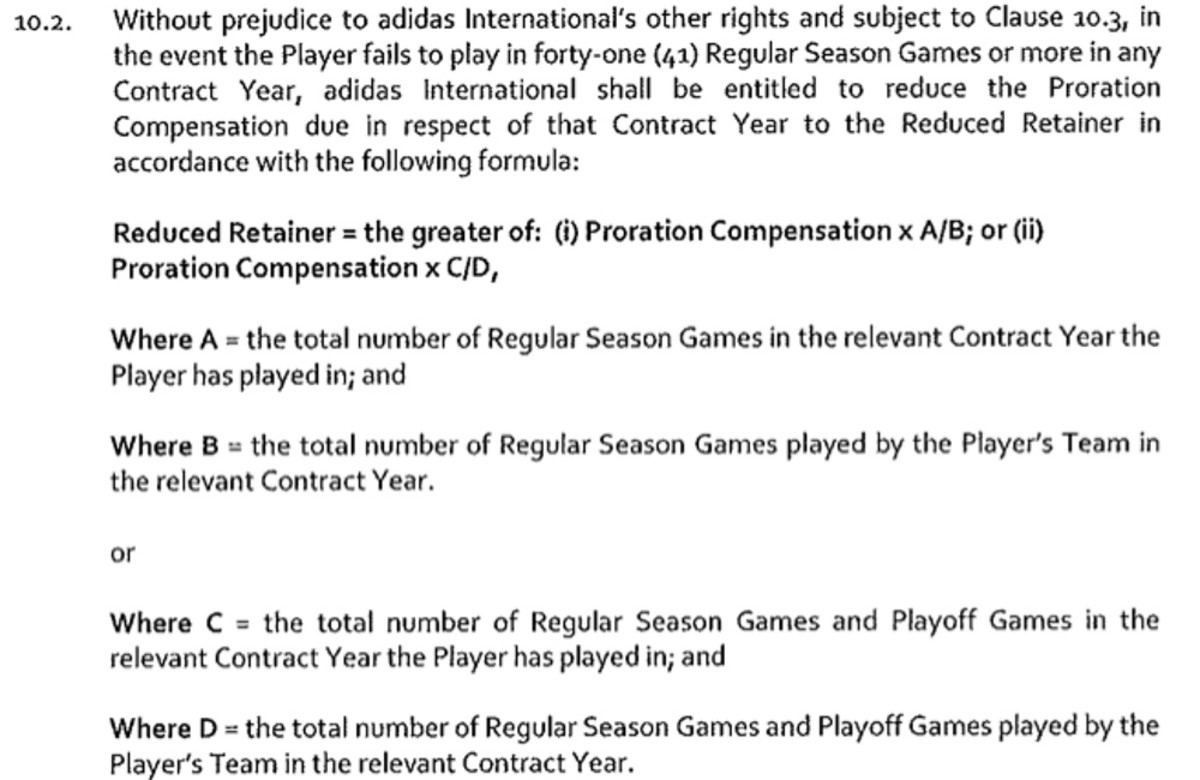
McCann: At different points in the contract, Adidas protected itself from being obligated to pay Rose. Towards the end of the contract, Adidas gained the right to reduce payments to Rose in the event that he failed to play in at least 41 regular season games during any particular season. A subsequent provision prevented Adidas from invoking this right in the event that Rose earned an All Pro award. It also limited the impact of the reduction if other circumstances occurred (such as Rose winning an Olympic gold medal).
Rose failed to play in at least 41 games during the 2011-12 season, but still earned a spot on the NBA’s First Team. This meant the reduction could not occur.
Rose sat out the entire 2012-13 season due to his ACL injury and also failed to play in at least 41 games during the 2013-14 season and did not earn any "All Pro" awards. So far in 2017-18, Rose has played in 13 of the Cavaliers’ 50 regular–season games. This means that if Rose misses more than four of the team’s remaining 32 games he will have failed to play in 41 regular season games during 2017-18 as well.
As Wertheim explores, there is no indication that Adidas invoked this language during the 2012-13 or 2013-14 seasons. It is unclear why they declined to do so.
17. The Rose-Adidas contract is supposed to be confidential (page 31)
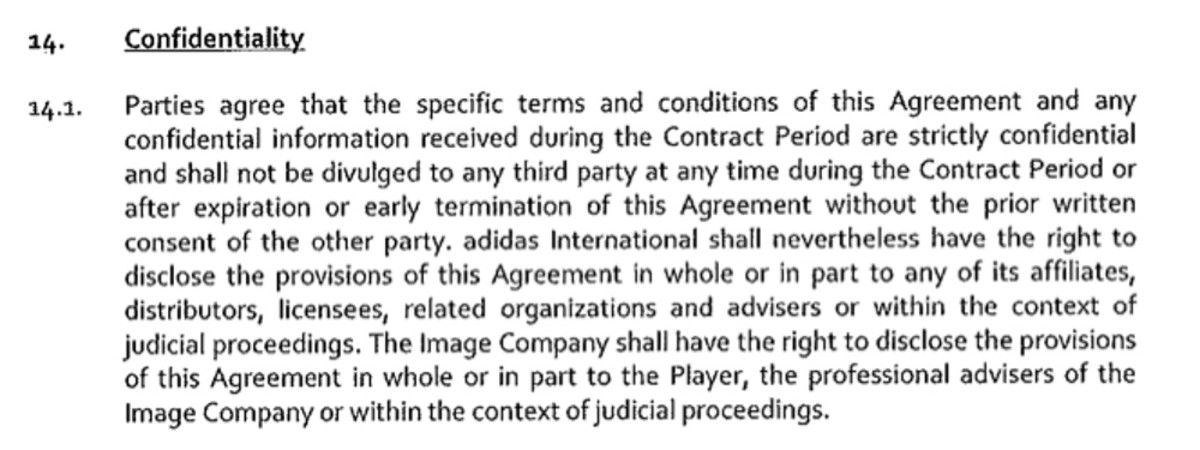
McCann: Endorsement deals are negotiated as confidential contracts. Unless a judicial proceeding compels disclosure, all parties to the contract are usually forbidden from disclosing its terms. That is true of the Rose-Adidas deal.
Yet in sports, more than a few confidential contracts have been shared with the public or media. Parties entering into such a contract should realize, and accept, that confidentiality may not prove as certain as the contract’s language makes it sound.
18. Any contractual disputes between Rose and Adidas would first go to mediation, then—if necessary—to arbitration and only then—if necessary—to court (page 32)
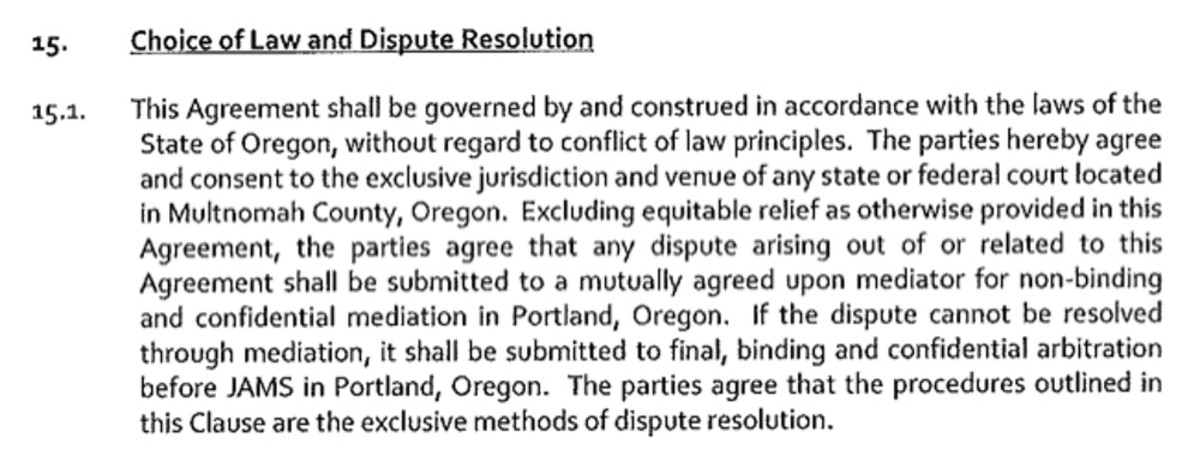
McCann: Often when we hear two parties are in disagreement about a legal issue, the possibility of a lawsuit comes to mind. Neither Adidas nor Rose would likely want a court to solve any such dispute. A lawsuit is public and can lead to both sides being required to make disclosures about sensitive information. In some cases such information can become public. As a publicly traded company, Adidas is especially mindful of how damaging company information could impact stock prices.
To avoid the eyes of the public, Adidas and Rose contractually agreed to first resolve any dispute before a mediator. Mediation is private and confidential and involves both sides making arguments before a mediator (who is often an attorney or retired judge). The mediator then recommends a solution to the dispute. The recommendation only goes into effect if both sides agree to follow it.
Adidas and Rose also agree that, if mediation fails, their dispute would then turn to arbitration. Like mediation, arbitration is typically private and confidential. Instead of arguing before a mediator, the parties argue before an arbitrator. And instead of “recommending” a solution, the arbitrator issues an award. The award is binding on both parties.
The losing side can then seek to have a federal court review the arbitration award. But federal courts review arbitration awards with a high degree of deference—a fact that sometimes deters a losing side from even bothering with a lawsuit.
Point being: Adidas and Rose have largely contracted away the possibility that they will ever face off against one another in court.
19. Adidas can do more with the endorsement deal than can Rose (page 32)

McCann: Adidas International Marketing—the global company with whom Rose signed his deal—is more than just Adidas. It also includes Reebok and several other sports and apparel companies, such as the running and fitness technology company Runtastic. Adidas negotiated the right to transfer certain aspects of Rose’s endorsement deal to those other brands—and to do so without Rose’s permission.
In contrast, Rose can’t assign his obligations under the deal without Adidas’s blessing. The underlying logic is that Rose’s obligations are about Rose and not other players. If Rose were permitted to hire another NBA player to fulfill Rose’s obligations to Adidas, Adidas would have been less inclined, if not outright unwilling, to do a deal with Rose in the first place.
20. Bonus payments lend insight on how Adidas values different NBA awards (page 37)
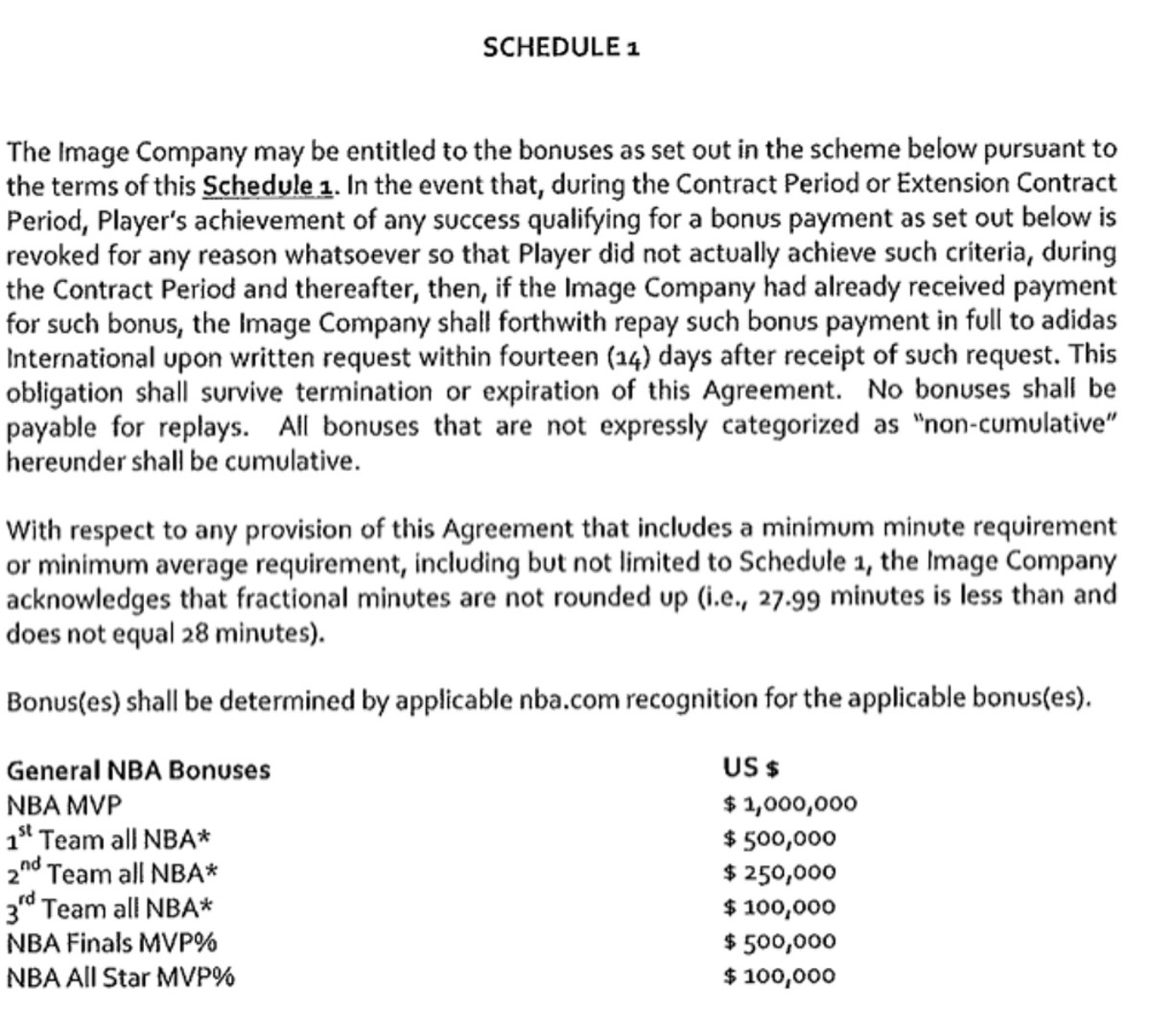
McCann: The endorsement deal signed by Rose contains opportunities for him to earn bonus money. Winning the MVP Award nets the highest bonus: $1 million. The next tier of bonuses is worth $500,000. That tier includes winning the NBA Finals MVA award, making NBA First Team, winning an NBA championship (provided he averages at least 30 minutes per game) or winning an Olympic Gold or World Championship Gold (provided he averages at least 15 minutes per game). Further down the list would be winning the NBA All–Star Game MVP Award, which would provide Rose with a $100,000 bonus.
Whether these monetary incentives impact how much Rose—or any NBA player—would want to win a Gold Medal for his country or how hard he would play in the NBA Finals isn’t clear. It’s possible the drive to win alone would be enough incentive. But these numbers show that players’ earnings can be significantly impacted by how those players are regarded by their peers, coaches and fans.
Michael McCann, SI's legal analyst, provides legal and business analysis for The Crossover. He is also the Associate Dean for Academic Affairs at the University of New Hampshire School of Law and co-author with Ed O'Bannon of the forthcoming book Court Justice: The Inside Story of My Battle Against the NCAA.
